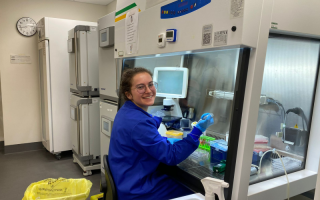We go behind the scenes in Gabriele Lignani’s lab to hear about inventing breakthrough gene therapies, moving to Grays Inn Road and what to expect from new PhD student's typical day.
Based at Queen Square House, Dr. Gabriele Lignani is Associate Professor in the Department of Clinical and Experimental Epilepsy at UCL Queen Square Institute of Neurology. The Lignani lab is made up of 12 people, including five research fellows, four PhD students and three research assistants.

Currently the main focus of my lab is finding novel gene therapy approaches for intractable neurological diseases, with rapid potential for translation. We use insights from investigations of the pathophysiological mechanisms of diseases and we develop and improve therapeutic tools to cure them.
In the lab we use cutting-edge molecular technologies such as CRISPR and novel promoters to overcome current limitations to gene therapy and develop new approaches for currently untreatable neurodevelopmental genetic diseases such as Dravet Syndrome, Focal Cortical Dysplasia and Episodic Ataxia Type 1.
We also work hard on finding novel therapies for adult neurological diseases such as acquired pharmaco-resistant epilepsies and Alzheimer’s disease. We developed the first gene therapy approach based on CRISPR to cure genetic epilepsies caused by haploinsufficiency and acquired pharmaco-resistance epilepsies (Colasante, Lignani et al. Molecular Therapy 2020; Colasante, Qiu et al. Brain 2020).
Recently we also proposed a new way of designing genetic therapies for brain circuit disorders which led to interest from the scientific community (Qiu et al. Science 2022).
The lab uses several advanced techniques to investigate the pathophysiological mechanisms of disease and to test out therapies, ranging from molecular biology to in vitro and in vivo electrophysiology. We usually begin our experiments in cell lines and in vitro neuronal culture to then move to animal models of different neurological disease and “mini brain” organoids, derived from patients’ stem cells. This broad range of techniques and models allows us to cover all the experimental pipeline from conceptualisation to pre-clinical validation, ready for translation to the clinic in a short time.
We collaborate with groups at UCL, nationally, and worldwide to complement our techniques and to accelerate our goal of finding innovative cures for devastating pathologies.
The longterm vision of our lab is to provide effective treatments for currently intractable neurological diseases using genetic therapy technologies.
Indeed, recently, with other UCL colleagues (Profs Dimitri Kullmann, Matthew Walker and Stephanie Schorge) we founded an epilepsy gene therapy spinout company (EpilepsyGTx), with support from UCL Business (UCLB) and the UCL Tech Fund. The company takes advantage of our lab expertise and aims to accelerate the translational pipeline of our work on novel therapies.
Soon the lab will move to the new ION-DRI facility on Grays Inn Road. We are very excited about this because the new centre will create a more collaborative work environment, with UCLH and UCL researchers from different backgrounds working together to find cures for neurological diseases. This is a great opportunity for our lab, and we hope to share our expertise with other groups that work on other pathologies to obtain better treatments for patients without any proper medications. We already have ongoing collaborations with groups moving into the new centre and we are sure that working closely to them will improve our scientific outputs. We are looking forward to the move to the new building!
 Close
Close



